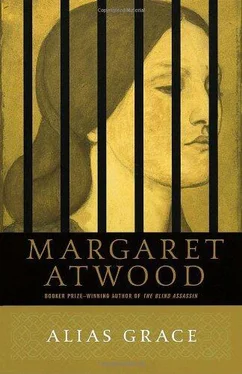Margaret Atwood - Alias Grace
Здесь есть возможность читать онлайн «Margaret Atwood - Alias Grace» весь текст электронной книги совершенно бесплатно (целиком полную версию без сокращений). В некоторых случаях можно слушать аудио, скачать через торрент в формате fb2 и присутствует краткое содержание. Жанр: Старинная литература, на английском языке. Описание произведения, (предисловие) а так же отзывы посетителей доступны на портале библиотеки ЛибКат.
- Название:Alias Grace
- Автор:
- Жанр:
- Год:неизвестен
- ISBN:нет данных
- Рейтинг книги:4 / 5. Голосов: 1
-
Избранное:Добавить в избранное
- Отзывы:
-
Ваша оценка:
- 80
- 1
- 2
- 3
- 4
- 5
Alias Grace: краткое содержание, описание и аннотация
Предлагаем к чтению аннотацию, описание, краткое содержание или предисловие (зависит от того, что написал сам автор книги «Alias Grace»). Если вы не нашли необходимую информацию о книге — напишите в комментариях, мы постараемся отыскать её.
Alias Grace — читать онлайн бесплатно полную книгу (весь текст) целиком
Ниже представлен текст книги, разбитый по страницам. Система сохранения места последней прочитанной страницы, позволяет с удобством читать онлайн бесплатно книгу «Alias Grace», без необходимости каждый раз заново искать на чём Вы остановились. Поставьте закладку, и сможете в любой момент перейти на страницу, на которой закончили чтение.
Интервал:
Закладка:
Moodie’s retelling of the murder is a third-hand account. In it she identifies Grace as the prime mover, driven by love for Thomas Kinnear and jealousy of Nancy, and using the promise of sexual favours to egg McDermott on. McDermott is portrayed as besotted by her and easily manipulated. Moodie can’t resist the potential for literary melodrama, and the cutting of Nancy‘s body into four quarters is not only pure invention but pure Harrison Ainsworth. The influence of Dickens’ Oliver Twist — a favourite of Moodie’s — is evident in the tale of the bloodshot eyes that were said to be haunting Grace Marks. Shortly after she saw Grace in the penitentiary, Susanna Moodie encountered her in the Lunatic Asylum in Toronto, where she was confined on the violent ward. Moodie’s first-hand observations are generally trustworthy, so if she reports a shrieking, capering Grace, that is no doubt what she saw. However, soon after the publication of Moodie’s book — and just after the appointment of the humane Joseph Workman as Medical Superintendent of the asylum — Grace was considered sane enough to be returned to the penitentiary; where, records show, she was suspected of having become pregnant during her absence. This was a false alarm, but who at the asylum could have been the supposed perpetrator?
The wards of the asylum were segregated; the men with the easiest access to the female patients were the doctors.
Over the next two decades, Grace turns up in the penitentiary records from time to time. She was certainly literate, as the warden’s journal depicts her as writing letters. She so impressed a good many respectable persons — clergymen among them — that they worked tirelessly on her behalf and submitted many petitions aimed at securing her release, seeking medical opinion to bolster their case. Two writers state that she was a trusted servant for many years in the home of the “Governor” —
probably the governor of the penitentiary — although the admittedly incomplete prison records do not mention this. However, it was the custom of the time in North America to hire out prisoners for day-labour.
In 1872, Grace Marks was finally granted a pardon; records show that she went to New York State, accompanied by the warden and his daughter, to a “home provided.” Later writers claim that she married there, although no proof for this exists; and, after this date, all trace of her vanishes. Whether she was indeed the co-murderer of Nancy Montgomery and the lover of James McDermott is far from clear; nor whether she was ever genuinely “insane,” or only acting that way — as many did — to secure better conditions for herself. The true character of the historical Grace Marks remains an enigma. Thomas Kinnear appears to have come from a lowland Scots family from Kinloch, near Cupar, in Fife, and to have been the younger half-brother of the heir to the estate; although, strangely, a late-nineteenth-century edition of Burke’s Peerage lists him as having died about the same time as he turned up in Canada West. The Kinnear house in Richmond Hill remained standing until late in the century and was a point of interest for sightseers. Simon Jordan’s visit to it is based on an account by one of them. The graves of Thomas Kinnear and Nancy Montgomery are in the Presbyterian churchyard in Richmond Hill, although unmarked. William Harrison, writing in 1908, reports that the wooden pickets around them were taken down, at a time when all wooden markers were removed. Nancy‘s rose bush has similarly disappeared.
Some further notes: Details of prison and asylum life are drawn from available records. Most of the words in Dr. Workman’s letter are his own. “Dr. Bannerling” expresses opinions that were attributed to Dr. Workman after his death, but which could not possibly have been his. The design of the Parkinson residence has a great deal in common with that of Dundurn Castle, in Hamilton, Ontario. Lot Street in Toronto was formerly the name of a portion of Queen Street. The economic history of Loomisville, and its treatment of mill girls, loosely echoes that of Lowell, Massachusetts. The fate of Mary Whitney has a parallel in the medical records of Dr. Langstaff of Richmond Hill. The portraits of Grace Marks and James McDermott on page ten are from their Confessions, published by the Toronto Star and Transcript.
The Spiritualist craze in North America began in Upper New York State at the end of the 1840s with the
“rappings” of the Fox sisters, who were originally from Belleville — where Susanna Moodie was by then resident, and where she became a convert to Spiritualism. Although it soon attracted a number of charlatans, the movement spread rapidly and was at its height in the late 1850s, being especially strong in upstate New York and in the Kingston-Belleville area. Spiritualism was the one quasi-religious activity of the times in which women were allowed a position of power — albeit a dubious one, as they themselves were assumed to be mere conduits of the spirit will.
Mesmerism was discredited as a reputable scientific procedure early in the century, but was widely practised by questionable showmen in the 1840s. As James Braid’s “Neuro-hypnotism,” which did away with the idea of a “magnetic fluid,” mesmerism began a return to respectability, and by the 1850s had gained some following among European doctors, although not yet the wide acceptance as a psychiatric technique that it was to achieve in the last decades of the century.
The rapid generation of new theories of mental illness was a characteristic of the mid-nineteenth century, as was the creation of clinics and asylums, both public and private. There was intense curiosity and excitement about phenomena such as memory and amnesia, somnambulism, “hysteria,” trance states,
“nervous diseases,” and the import of dreams, among scientists and writers alike. The medical interest in dreams was so widespread that even a country doctor such as Dr. James Langstaff was recording the dreams of his patients. “Dissociation of personality,” or dédoublement, was described early in the century; it was being seriously debated in the 1840s, although it achieved a much greater vogue in the last three decades of the century. I have attempted to ground Dr. Simon Jordan’s speculations in contemporary ideas that would have been available to him.
I have of course fictionalized historical events (as did many commentators on this case who claimed to be writing history). I have not changed any known facts, although the written accounts are so contradictory that few facts emerge as unequivocally “known.” Was Grace milking the cow or gathering chives when Nancy was hit with the axe? Why was Kinnear’s corpse wearing McDermott’s shirt, and where did McDermott get that shirt — from a peddler, or from an army friend? How did the blood-covered book or magazine get into Nancy‘s bed? Which of several possible Kenneth MacKenzies was the lawyer in question? When in doubt, I have tried to choose the most likely possibility, while accommodating all possibilities wherever feasible. Where mere hints and outright gaps exist in the records, I have felt free to invent.
Интервал:
Закладка:
Похожие книги на «Alias Grace»
Представляем Вашему вниманию похожие книги на «Alias Grace» списком для выбора. Мы отобрали схожую по названию и смыслу литературу в надежде предоставить читателям больше вариантов отыскать новые, интересные, ещё непрочитанные произведения.
Обсуждение, отзывы о книге «Alias Grace» и просто собственные мнения читателей. Оставьте ваши комментарии, напишите, что Вы думаете о произведении, его смысле или главных героях. Укажите что конкретно понравилось, а что нет, и почему Вы так считаете.












